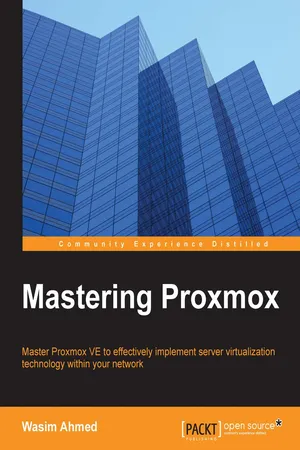![]()
![]()
Table of Contents
Mastering Proxmox
Credits
About the Author
About the Reviewers
www.PacktPub.com
Support files, eBooks, discount offers, and more
Why subscribe?
Free access for Packt account holders
Preface
What this book covers
What you need for this book
Who this book is for
Conventions
Reader feedback
Customer support
Downloading the example code
Errata
Piracy
Questions
1. Dive into the Virtual World with Proxmox
Proxmox cluster required
The Proxmox Graphical User Interface (GUI)
The GUI menu system
Menu chart
The Datacenter menu
The Search tab
The Storage tab
The Backup tab
Node-specific tabs
The Summary tab
The Network tab
The Syslog tab
The UBC tab
The Subscription tab
The Updates tab
The Ceph tab
Virtual machine tabs
The Summary tab
The Hardware tab
The Options tab
The Backup tab
The Snapshots tab
The Permissions tab
Setting up a basic cluster
The hardware list
The software list
Hardware setup
Proxmox installation
Cluster creation
Proxmox subscription
Attaching shared storage
Adding virtual machines
Main virtual machine
Creating a KVM virtual machine
Creating an OpenVZ virtual machine
Proxmox cloning/template
Introducing cloning using a template
Transforming VM into a template
Cloning using a template
Full Clone versus Linked Clone
VM migration
Summary
2. Proxmox Under the Hood
The Proxmox cluster directory structure
Dissecting the configuration files
The cluster configuration file
The storage configuration file
Local directory-based storage
NFS-shared storage
iSCSI/LVM shared storage
User configuration files
The password configuration file
The virtual machine configuration file
Arguments in the KVM configuration file
The Proxmox OpenVZ configuration file
The version configuration file
Member nodes
The .members file
The virtual machine list file
The cluster logfile
Summary
3. Shared Storages with Proxmox
Local storage versus shared storage
Live migration of a virtual machine
Seamless expansion of multinode storage space
Centralized backup
Multilevel data tiering
Central storage management
Local and shared storage comparison
Virtual disk image
Supported image formats
The .qcow2 image type
The .raw image type
The .vmdk image type
Image file manipulation
Resizing virtual disk image
Moving a virtual disk image
Storage types in Proxmox
Directory
Logical Volume Management
Network File System
RADOS Block Device
GlusterFS
Noncommercial/commercial storage options
FreeNAS – budget shared storage
Summary
4. A Virtual Machine for a Virtual World
Creating a VM from a template
Advanced configuration options for a VM
The hotplugging option for a VM
The hotplugging option for <vmid>.conf
Loading modules
Adding virtual disk/vNIC
Nested virtual environment
Enabling KVM hardware virtualization
Network virtualization
Backing up a virtual machine
Proxmox backup and snapshot options
Backing up a VM with a full backup
Creating a schedule for Backup
Node
Storage
Day of Week
Start Time
Selection mode
Send email to
Compression
Mode
Creating snapshots
Deleting old backups
Restoring a virtual machine
Command-line vzdump
Backup configuration file – vzdump.conf
#bwlimit
#lockwait
#stopwait
#script
#exclude-path
Summary
5. Network of Virtual Networks
Introduction to a virtual network
Physical network versus virtual network
Physical network
Virtual network
Networking components in Proxmox
Virtual Network Interface Card (vNIC)
Virtual bridge
Virtual LAN (VLAN)
Network Address Translation/Translator (NAT)
Network bonding
Components naming convention
Network configuration file
bridge_stp
bridge_fd
Adding a virtual bridge
Adding a bonding interface
Adding NAT/masquerading
Adding VLAN
Sample virtual networks
Network #1 – Proxmox in its simplest form
Network #2 – multitenant environment
Network #3 – academic institution
Multitenant virtual environment
Multitenant network diagram
Summary
6. Proxmox HA – Zero Downtime
Understanding High Availability
High Availability in Proxmox
Requirements for HA setup
Fencing
Configuring Proxmox HA
Setting up node BIOS
Creating an APC-managed PDU user
Configuring Proxmox fencing
Configuring virtual machine HA
Testing Proxmox HA
Fencing manually
Proxmox HA need to know
Summary
7. High Availability Storage for High Availability Cluster
Introducing the Ceph storage
Object Storage
Block Storage
Filesystem
Reasons to use Ceph
Virtual Ceph for training
The Ceph components
Physical node
Maps
Cluster map
CRUSH map
Monitor
OSD
OSD Journal
MDS
Placement Group (PG)
Pool
Ceph components summary
The Ceph cluster
Hardware requirements
Software requirements
Installing Ceph usi...
